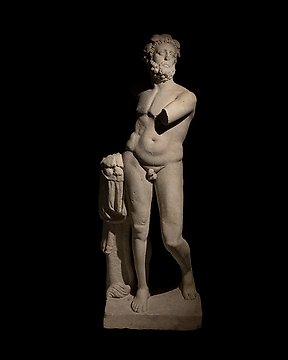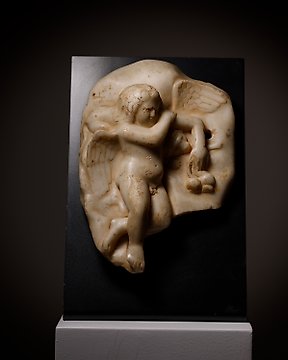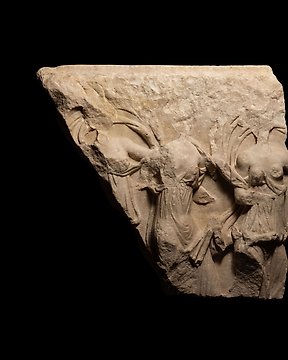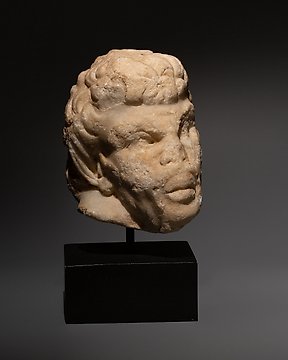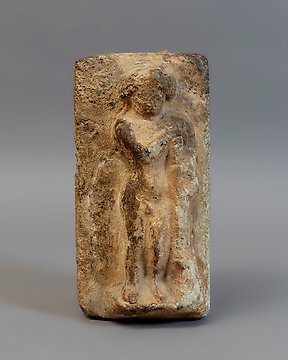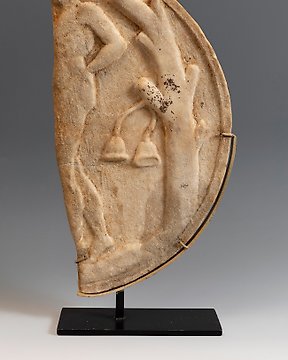Pezzo come da descrizione, davvero notevole. Venditore molto consigliato in quanto gentile e disponibile. spedizione molto veloce. Ottimo!
Se översättningRomerska antiken Marmor Chef för en Satyr. 1:a - 3:e århundradet e.Kr. 30 cm H. Spanskt exporttillstånd.
Nr 84871065



Head of a Satyr
- refined style -
Roman Empire, 1st - 3rd century AD
MATERIAL: Marble.
DIMENSIONS: 30 cm height with stand, 17 cm height without stand.
PROVENANCE: Private collection, Berlin, Germany. Old collection before 2nd world war.
CONDITION: Good conditon, not restored.
DESCRIPTION:
Roman head made in marble representing a satyr, which can be deduced from the treatment of the hair, through the somewhat anarchic-looking curls (although, due to erosion, part of this disorderly representation of the locks has been lost) and, above all, the large mouth, insinuating a sardonic smile, which are common characteristics in the representation of this mythological character. The carver combines idealism and realism, a fact that was common in Roman statuary. The hair, the treatment of the eyes, and the strict symmetry bring us closer to this idealism that sought to represent harmony. However, the protruding lips and cheekbones show an almost animalistic expressiveness.
Related to the Maenads, the satyrs form the 'Dionysian retinue' that accompanies the god Dionysus. They are depicted in various forms; the most common (and basically Roman) is that of a half-man half-ram creature, with pointed ears and horns on the head, abundant hair, a flat nose, a goat's tail and a permanent priapism. One tradition considered the sons of Silenus, named Maron, Leneus and Astreo, to have been the fathers of the satyrs. All three were in the retinue of Dionysus when he travelled to India and, in fact, Astreo was the driver of his chariot. As we can see in this Roman sculpture, satyrs are cheerful and mischievous creatures, although their lighthearted and festive nature can turn dangerous and even violent (which explains why our sculpture has a frown on its face). As Dionysian creatures, they are lovers of wine and enjoy carnal pleasures.
Satyr and Silenus, in Greek mythology, creatures of the wild, part man and part beast, who in Classical times were closely associated with the god Dionysus. Their Italian counterparts were the Fauns (see Faunus). Satyrs and Sileni were at first represented as uncouth men, each with a horse’s tail and ears and an erect phallus. In the Hellenistic age they were represented as men having a goat’s legs and tail. The occurrence of two different names for the creatures has been explained by two rival theories: that Silenus was the Asian Greek and Satyr the mainland name for the same mythical being; or that the Sileni were part horse and the Satyrs part goat. Neither theory, however, fits all the examples in early art and literature. From the 5th century BC the name Silenus was applied to Dionysus’ foster father, which thus aided the gradual absorption of the Satyrs and Sileni into the Dionysiac cult. In the Great Dionysia festival at Athens three tragedies were followed by a Satyr play (e.g., Euripides’ Cyclops), in which the chorus was dressed to represent Satyrs. Silenus, although bibulous like the Satyrs in the Satyr plays, also appeared in legend as a dispenser of homely wisdom.
In art the Satyrs and Sileni were depicted in company with nymphs or Maenads whom they pursued. (Their amorous relations with nymphs are described as early as the Homeric Hymn to Aphrodite.) The Greek sculptor Praxiteles represented a new artistic type in which the Satyr was young and handsome, with only the smallest vestiges of animal parts. Hellenistic artists developed that concept into humorous or forceful representation of half-animal subjects as an escape from the merely human.
Notes:
The seller guarantees that he acquired this piece according to all national and international laws related to the ownership of cultural property. Provenance statement seen by Catawiki.
The seller will take care that any necessary permits, like an export license will be arranged, he will inform the buyer about the status of it if this takes more than a few days.
The piece includes authenticity certificate.
The piece includes Spanish Export License.
#historyroom
Säljarens berättelse
Head of a Satyr
- refined style -
Roman Empire, 1st - 3rd century AD
MATERIAL: Marble.
DIMENSIONS: 30 cm height with stand, 17 cm height without stand.
PROVENANCE: Private collection, Berlin, Germany. Old collection before 2nd world war.
CONDITION: Good conditon, not restored.
DESCRIPTION:
Roman head made in marble representing a satyr, which can be deduced from the treatment of the hair, through the somewhat anarchic-looking curls (although, due to erosion, part of this disorderly representation of the locks has been lost) and, above all, the large mouth, insinuating a sardonic smile, which are common characteristics in the representation of this mythological character. The carver combines idealism and realism, a fact that was common in Roman statuary. The hair, the treatment of the eyes, and the strict symmetry bring us closer to this idealism that sought to represent harmony. However, the protruding lips and cheekbones show an almost animalistic expressiveness.
Related to the Maenads, the satyrs form the 'Dionysian retinue' that accompanies the god Dionysus. They are depicted in various forms; the most common (and basically Roman) is that of a half-man half-ram creature, with pointed ears and horns on the head, abundant hair, a flat nose, a goat's tail and a permanent priapism. One tradition considered the sons of Silenus, named Maron, Leneus and Astreo, to have been the fathers of the satyrs. All three were in the retinue of Dionysus when he travelled to India and, in fact, Astreo was the driver of his chariot. As we can see in this Roman sculpture, satyrs are cheerful and mischievous creatures, although their lighthearted and festive nature can turn dangerous and even violent (which explains why our sculpture has a frown on its face). As Dionysian creatures, they are lovers of wine and enjoy carnal pleasures.
Satyr and Silenus, in Greek mythology, creatures of the wild, part man and part beast, who in Classical times were closely associated with the god Dionysus. Their Italian counterparts were the Fauns (see Faunus). Satyrs and Sileni were at first represented as uncouth men, each with a horse’s tail and ears and an erect phallus. In the Hellenistic age they were represented as men having a goat’s legs and tail. The occurrence of two different names for the creatures has been explained by two rival theories: that Silenus was the Asian Greek and Satyr the mainland name for the same mythical being; or that the Sileni were part horse and the Satyrs part goat. Neither theory, however, fits all the examples in early art and literature. From the 5th century BC the name Silenus was applied to Dionysus’ foster father, which thus aided the gradual absorption of the Satyrs and Sileni into the Dionysiac cult. In the Great Dionysia festival at Athens three tragedies were followed by a Satyr play (e.g., Euripides’ Cyclops), in which the chorus was dressed to represent Satyrs. Silenus, although bibulous like the Satyrs in the Satyr plays, also appeared in legend as a dispenser of homely wisdom.
In art the Satyrs and Sileni were depicted in company with nymphs or Maenads whom they pursued. (Their amorous relations with nymphs are described as early as the Homeric Hymn to Aphrodite.) The Greek sculptor Praxiteles represented a new artistic type in which the Satyr was young and handsome, with only the smallest vestiges of animal parts. Hellenistic artists developed that concept into humorous or forceful representation of half-animal subjects as an escape from the merely human.
Notes:
The seller guarantees that he acquired this piece according to all national and international laws related to the ownership of cultural property. Provenance statement seen by Catawiki.
The seller will take care that any necessary permits, like an export license will be arranged, he will inform the buyer about the status of it if this takes more than a few days.
The piece includes authenticity certificate.
The piece includes Spanish Export License.
#historyroom
Säljarens berättelse
- 752
- 7
- 0
Venditore davvero ottimo e gentile. Merce come da descrizione, spedizione veloce. Ottimo l'avere certificato di autenticità.
Se översättningUn 100 como empresa un 100 como envío . Empresa muy especial con mucha exquisitez en todos los productos y en personal . Muchas gracias
Se översättningAll well! Thanks.
Se översättningVery nice and fine cut little jewel! Well packed too! Thanks!
Se översättningnice piece and very fast shipping!
Se översättningEs una maravilla de moneda, donde se le nota los pasos de los años y me encanta. Servido muy rápido y bien empaquetado. Con su certificación. Qué más se puede pedir?
Se översättningSnelle en correcte levering, alleen was de verpakking voor het schilderij niet stevig genoeg.
Se översättningHerzlichen Dank!
Se översättningAll OK and with very fast shipping.
Se översättningPrachtig schilderij. Zo blij mee. Zeer nette verkoper en zeer snelle levering.
Se översättningperfect ! very fast and high quality delivery !
Se översättningAll well! Thanks.
Se översättningVendeur très professionnel, top +++×
Se översättningPhotos trop contrastées pour bien percevoir les défauts, mais ces défauts étaient visibles pour autant. Le "Bon état" est trompeur. Sinon, envoi rapide et correctement emballé. Frais de port exagérés.
Se översättningGreat communication, delivery and product. Came with a well made certificate of authenticity and good packaging. Overall very happy with the purchase! Delivery is a bit expensive, but I recommend it
Se översättningMagnifique témoin du passé, envoyé avec tous les justificatifs, impeccable. Encore une fois très satisfait, un grand merci
Se översättningThank you for the Special offer and the fast shipping of this excellent piece of art!
Se översättningvery good description of the object, very good price for this rare item,. Fast sending (has been at my place 2 days after buying!). Definitely would buy again.
Se översättningSehr schön
Se översättningAs described, perfect logistic
Se översättninggreat seller, everything came as should with certificate of authenticity
Se översättningExceptionally well packaged, description aligned with positing received
Se översättningReally precious, but without sound...
Se översättningPainting well packed and rapidly sent!
Se översättning- 752
- 7
- 0
Pezzo come da descrizione, davvero notevole. Venditore molto consigliato in quanto gentile e disponibile. spedizione molto veloce. Ottimo!
Se översättningAnsvarsfriskrivning
Säljaren garanterar och kan bevisa att objektet införskaffats på lagligt sätt. Säljaren har informerats av Catawiki att de måste lämna den dokumentation som är obligatorisk enligt lagar och regler i det land de är bosatta. Säljaren garanterar och har rätt att sälja/exportera detta objekt. Säljaren tillhandahåller all information om härkomst som är känd om objektet till köparen. Säljaren säkerställer att alla nödvändiga tillstånd är/kommer att bli ordnade. Säljaren informerar köparen omedelbart om eventuella förseningar gällande att anskaffa sådana tillstånd.
Säljaren garanterar och kan bevisa att objektet införskaffats på lagligt sätt. Säljaren har informerats av Catawiki att de måste lämna den dokumentation som är obligatorisk enligt lagar och regler i det land de är bosatta. Säljaren garanterar och har rätt att sälja/exportera detta objekt. Säljaren tillhandahåller all information om härkomst som är känd om objektet till köparen. Säljaren säkerställer att alla nödvändiga tillstånd är/kommer att bli ordnade. Säljaren informerar köparen omedelbart om eventuella förseningar gällande att anskaffa sådana tillstånd.
